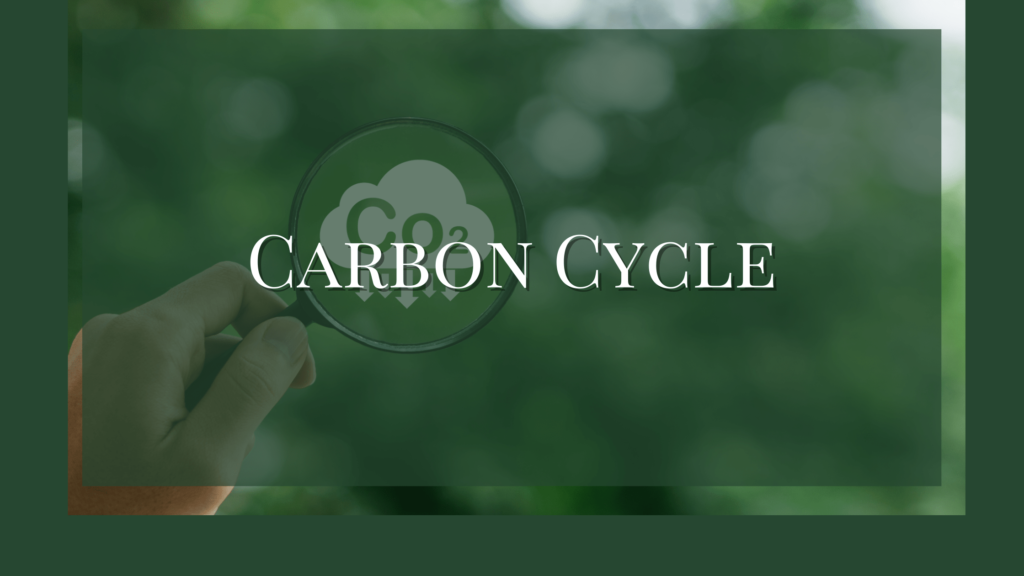To explain carbon cycle, it is essential to understand its importance in nature. Carbon is the basic element of all organic compounds in the living community. The carbon source of the biotic community is the free carbon dioxide in the air and a large amount of this gas is dissolved in the water.
The carbon cycle is the cyclic movement of elemental carbon through various compounds between the atmosphere, biosphere, hydrosphere, and lithosphere. The cycle utilizes carbon for various biological and chemical processes in nature and also replenishes it for further usage.
Explain Carbon Cycle
- Carbon moves from the environment in the form of carbon dioxide into the producers or plants through photosynthesis and gets converted into organic carbon.
- The organic form of carbon moves into the consumer community.
- Animals and plants release carbon dioxide into the atmosphere through respiration.
- Then it is passed to the decomposers from both the trophic levels and finally reenters the environment.
- Automobile combustion and industrial emissions contribute to a major share of atmospheric carbon dioxide.
- The usage of electrical appliances is another contributor to atmospheric carbon dioxide.
- The dead and decaying matter gets converted into fossils after millions of years.
- Apart from this, a major portion of carbon is stored in various rocks and soil.
Thus, atmospheric carbon dioxide passes through various animals and plants and returns to the atmosphere. Similarly, automobiles that use petroleum products return carbon as emissions. Plants use this carbon dioxide to assmiliate it. This is perfectly a cyclic process.
The percentage of carbon dioxide in the air is meager, approximately 0.03 to 0.04%. The aquatic and terrestrial plants and the chemosynthetic bacteria consume enormous amounts of this gas.
Yet, the concentration of carbon dioxide in the ecosystem remains almost at the same level. This is because carbon dioxide is being returned to the atmosphere in several ways and in nature there is a dynamic equilibrium between the process of carbon dioxide consumption and production.
Carbon is either in the form of organic compounds passed between living organisms or stored in other forms in various sources of earth. The latter is mostly unusable or in the form of petroleum products.
Sources of Carbon Dioxide
In the production group of carbon dioxide, the most important process is respiration by plants and animals. The respiration of soil bacteria and other soil microorganisms alone returns more carbon dioxide than the respiration of all animals.
After the death of plants and animals, their residues are decomposed by bacteria and fungi which liberates carbon dioxide. A small portion of the carbon content of organic compounds of dead organisms is bound to the earth in the form of coal, natural gas, mineral oils, etc, as well as limestone.
Some of the carbon thus locked up is released to the atmosphere during fuel combustion and weathering of limestone etc. In this way, a regular carbon cycle is maintained in nature.
Carbon Cycle in Aquatic Ecosystem
The carbon dioxide content of the aquatic system plays an important role in maintianing the overall carbon dioxide content of the atmosphere at a constant level. The ocean occupies three-fourths of the earth’s surface and contains carbonates and bicarbonates in dissolved form. This is 30-40 times more carbon dioxide than what is present in the air.
The carbon dioxide stored in the oceans and coastal ecosystems is called blue carbon. The carbon dioxide in the ocean is in equilibrium with the carbon dioxide in the atmosphere. Whenever this equilibrium is disturbed, carbon dioxide begins to escape from the ocean into the atmosphere and vice versa, through diffusion.
The carbon dioxide in oceans and freshwater bodies also passes through a cycle due to the photosynthetic activity of plants in these ecosystems. The aquatic fauna and flora also contribute carbon dioxide through respiration and the decomposition of all these organisms.
References
- Shukla, R.S. and Chandel, P.S. (2001) Plant Ecology. S. Chand and Company Ltd., New Delhi.
- Verma, P.S., Agarwal, V.K. (1999). Cell biology genetics molecular biology evolution and ecology. New Delhi: S.Chand Co.(Pvt) Ltd.
- What is the carbon cycle?




